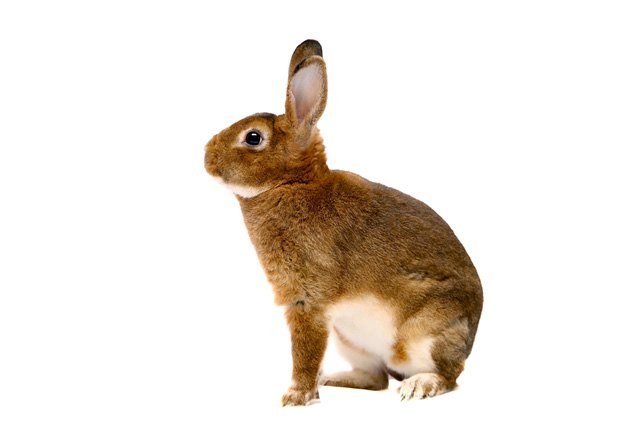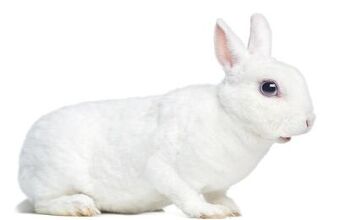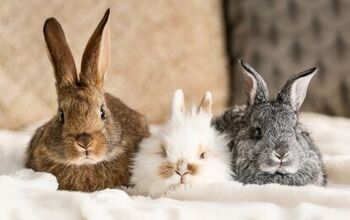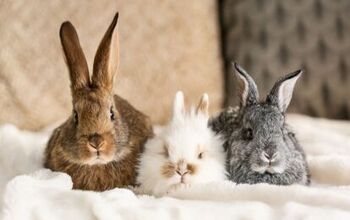Rex Rabbit


About Rex Rabbit
Rex Rabbit Breed History/Origin
The Rex Rabbit wasn’t born yesterday, ya know! This is an illustrious little bunny with quite a rich history worth exploring. The Rex Rabbit was developed around 1919 in the French village of Louché-Pringé, by breeders who were impressed by this wild rabbit’s beautiful and luscious fur. Naturally, they wanted to domesticate it! This stunning breed was gradually developed from a litter of wild gray rabbits. They were selectively bred into a domestic breed and shown in an international rabbit show in Paris in 1924, where there was great interest among breeders because of the recessive rex gene. The breed was an instant success! And for a number of reasons, too.
These rabbits may have been found int the wild initially, but they quickly exploded in popularity and became coveted as pets. Following its first showing in Paris, the breed was introduced to the United States that same year and was shown by American rabbit breeder John C. Fehr and his partner Alfred Zimmerman. The breed was accepted by the American Rabbit Breeder’s Association (ARBA) soon after. It’s been a stable in the homes of rabbit lovers ever since. To see a Rex Rabbit in person is to fall hard into bunny love. You’ll need to own one immediately and you won’t regret it. Read on as we learn all the tidbits that make this rabbit breed so wonderful!
The Rex rabbit has short, soft fur that points out instead of against their bodies, making this breed super plushy.
Overall Description
One glimpse is enough for you to know that you are dealing with a majestic Rex rabbit. The Rex rabbit has a commercial-sized body type and can weigh anywhere between 7.5 and 10.5 lbs. once fully grown. The ideal weight for bucks is around 8 pounds and 9 pounds for does. Pretty standard stuff, as the breed does not differentiate that much from many of its close relatives.
According to the ARBA Standard of Perfection, the Rex Rabbit is a well-proportioned animal, with medium body length, well-rounded hips and a loin, ribs, and shoulders that complement them. These rabbits are real lookers. In the rabbit world, their looks are pitch perfect - by all standards. Their head is broad and set close to the body and, as everything about these bunnies, it’s in perfect balance with the rest of their stunning physique. The ears are erect and medium thick, evenly covered with short plush fur typical of the breed, and their legs are short and straight.
As for the personality and behavior of the Rex Rabbit, you can expect this breed to be docile, friendly, and open to handling and petting. In other words, these are sweethearts and charmers in the rabbit world, destined to bring joy to any home that welcomes them in as a pet. Rabbits aren’t always the most social pets, so that makes this breed particularly attractive for bunny lovers who like to get up close and personal with their pets. They love receiving attention from their humans, which makes them ideal rabbits for homes with children (who are often disappointed by the antisocial nature of many rabbits).
Coat
Now onwards to the pride of every bunny – the coat! The Rex Rabbit has a unique gene which gives its coat a velvety texture. The coat is extremely dense, and the hair’s length and quality uniform all across the body. Hairs are short but not shorter than half an inch- or longer than ⅞ of an inch. This short, soft fur that points out instead of against their bodies like most rabbits makes this breed feel super plushy. Unfortunately, their smooth and dense fur made them interesting to the fur industry. Many horrible owners often kept this breed around for their pelts alone. Thankfully, we are long past that unfortunate chapter in Rex Rabbit's history. They are now owned only by those who love them as living beings regardless of how pretty their fur might be.
Now, when the Rex Rabbit is a popular pet, their unique coat is considered to be just one of their many charming qualities and not a source of profit. Despite its one-of-a-kind coat, though, this breed is not high maintenance when it comes to grooming. In fact, it requires even less grooming than other rabbit varieties. Owners should try to groom this rabbit as little as possible, as over-grooming can damage its coats. If there’s excess dirt on your rabbit’s coat, simply clean it with a damp cloth. Never bathe your bunny, as this causes great stress and can cause cardiac problems and even result in death. As much as you might enjoy bunny bath time, it’s simply not a good idea for your pet. Fortunately there are plenty of easy alternatives.
And if you are ever in doubt about your bunny’s coat and its quality, and you don’t know whether to brush or not, you can always find a local groomer that specializes in rabbits. They can be the helping hand you need – with their professional guidance, your Rex Rabbit pet can always look their absolute best.
Colors
After the coat, the colors are next in importance. After all, without a striking color, the coat of the velvety Rex won’t appear as majestic as it should. In the United States, there are 16 accepted coat colors for the Rex Rabbit breed. Some of these include castor, seal, chinchilla, opal, black, white, Californian, amber, as well as Broken (which is any color mixed with white). In other words there is a Rex Rabbit out there to suit any personal pet preference. Some of these colors are more desired than the others, so you’ll always find colors that are much more established on the market.
Rex Rabbits are great pets for seniors and first-time pet parents as well as singles or couples.
Care Requirements
To make sure your bunny stays healthy and happy under your roof, you will need to provide proper rabbit housing. The two main aspects to consider are the size and the type of materials. Enclosures need to be large enough for your rabbit to comfortably stretch out in, have enough room to play, do its business and eat. This translates to at least 12 feet of cage space (6 x 2 feet), coupled with a minimum of 32 square feet of bunny-safe playing space, which is usually fenced by a pen or a playpen gate.
As for the bunny-safe materials of the enclosures, choose indoor cages made of strong wire that have a solid bottom. Wire bottom at the cage is a big no-no, as it will hurt your bunny and lead to sore hocks. The enclosure needs to be lined with bedding, spot-cleaned every day and completely replaced at the end of every week.
In order to become a socialized, well-rounded rabbit, pets need to be taken out of its enclosures as often as possible and allowed to roam free in a bunny-safe room. The longer they interact with their human families, the sweeter and more docile (and playful!) they will become. More often than not, owners decide on giving their rabbit the free reign of home. Well, after rabbit-proofing everything, of course. Just make sure that the family is informed and instructed on how to properly take care of a Rex rabbit. If you live in a home with plenty of inquisitive kids, tell them that they must be quite careful around their bunny pet. Otherwise, they might end up hurting the poor thing. Also, it is best to always have your eye on the bunny, when they are free roaming around the house. This ensures that you always know where they are and that there is no danger. If you do consider having your bunny out in the house as any other pet, you need to remember that things like an open fireplace, electric cables lying around, unstable and heavy objects, and hard to reach constrained areas are a big danger.
Rabbits have extremely strong teeth and a tendency to chew everything, which often leads to catastrophe. Not only that your furniture or shoes could be ruined, but your bunny could die after nibbling on electric wires or eating a dangerous houseplant. So, to avoid any potential problems, ensure that the space is safe for your pet (and your valuables protected) before you let your bunny roam free. In case you have a garden or a backyard where your Rex Rabbit can play, make sure to let them out only in a well-secured pen and with you supervising them.
In terms of their ideal diet, the Rex Rabbit is no different than most other bunny breeds. Remember that the diet is the cornerstone of every pet’s health. This is especially true for bunnies. They should be fed only the best bunny foods, and you should never experiment with foods not suited to them. Your pet can end up in big trouble if you give them something they shouldn’t eat!
They require a diet that consists of 70 percent high-quality hay (such as orchard hay) with the rest being a good mix of leafy greens, fruits, pellets and vegetables. Hay such as alfalfa should only be given in moderation and fruits/vegetables which contain high levels of sugar should be used mostly as treats. Always research what kind of food you are giving to your rabbit, as there are some that are safe and others that can make them sick. Additionally, you should ensure your rabbit always has access to fresh and clean water.
Health
Unlike most animals, rabbit teeth never stop growing. Thankfully, they are also constantly being worn down by everyday activities such as chewing their food (mostly hay). If your rabbit’s teeth are not being worn down, its teeth may start growing into its jaw and face, causing severe pain. Signs of overgrown teeth or an infection due to overgrown teeth include loss of appetite, slugging activity or drooling around the mouth. A neglected rabbit that does not get a chance to grind their teeth down can end up in big trouble. Overgrown teeth can be potentially lethal, so always provide roughage and toys that can be nibbled on. Rabbits have the need to keep their teeth trimmed and sharp!
Be sure to check your rabbit’s mouth weekly for signs of overgrown teeth and bring them to the vet if you suspect they have an infection, as it can be treated with antibiotics, and veterinarians can also fix their overgrown teeth problem.
In addition to helping your bunny grind down their teeth, roughage (hay) will promote better digestion, too. Rabbits are avid groomers and will ingest a lot of their own hair during the self-cleaning process. Unfortunately, they can’t vomit hairballs like cats do, and instead, clumps of hair get stuck inside their intestines. This is known as GI stasis, a potentially fatal condition that affects all rabbits. To prevent it, feed a lot of high-quality hay, groom your pet regularly, especially in the heavy shedding seasons, and inspect their feces for signs of poop that looks like string of pearls.
Ears should also regularly be checked for ear mites, as this is a common condition in rabbits, especially outdoor rabbits.
If you decide to spay or neuter your rabbit, some owners notice that their rabbit tends to be less aggressive, however this breed of rabbit is not known to be hostile, so neutering your Rex may do nothing to its personality but make them calmer. Does can be spayed once they are 4-6 months old while bucks can be neutered as young as 3 and a half months old. Still, it might be best to “fix” the bucks, as that can soften their temperament quite a bit and make them more manageable. Some unfixed males could be territorial, and mark their territory with urine. This can leave your home smelling funky – but it is nothing that a little “snip” can’t fix.
There is, of course, their mental health too. Like any other animal, the Rex rabbit cannot be neglected. If you think that they can spend their entire day in a small enclosure, you are wrong. They need to play, run around, and exercise. These are social animals and if they are cooped up for hours on end, they can become bored, unhappy, and lethargic. And from there, it is a quick way towards serious health issues. That’s why you need to work towards breaking those stereotypes and considering this animal as a household pet. It needs your affection, care, and company. It would be best if you have a family – solo owners might find it challenging to provide plenty of care to a pet rabbit all on their own, especially if they work long hours.
In the end, a Rex Rabbit might be happiest in a family setting – an environment where there is always someone to look after them. A single owner with a busy schedule can find it difficult to complete the daily chores and still take care of the bunny full time. If you are not sure you can handle a pet on top of your daily schedule, it’s best not to commit. Or, perhaps, a different pet with little requirements might be a better choice.
Breeders/owners should try to groom Rex rabbits as little as possible, as over-grooming can damage their coats.
Temperament/Behavior
Rex rabbits are generally docile rabbits who won’t mind being picked up and petted, especially if it’s by a family who frequently lets them out of their cage to explore their surroundings. Like any domesticated animal, it will grow attached to the family member who spends the most time with them and feeds them the most often, but it will generally be unafraid of any person who picks them up with care and pets them. Still, it is important to do this gradually. While they are young, they should be getting used to being handled and being in crowds where it is noisy. Step by step. Doing it all at once and handling them roughly can cause a lot of stress which can result in them being frightful and avoiding handling.
Their low maintenance makes them great pets for seniors and first time pet parents as well as singles or couples who would like to try pet ownership. This rabbit breed is suitable for children so long as they understand how to pick up and care for rabbits, as it is a fragile animal and requires a different care than cats or dogs. If the child is gentle with its pet, you’d be surprised how welcoming and affectionate a Rex rabbit can be. They will love to be petted and will enjoy some quality playtime with their tiny human friend!
In terms of toys, each rabbit has its own personality and may enjoy some toys to chew and entertain itself with. It may be as simple as a toilet paper roll to an elaborate pet toy from your local pet store. Of course, pet rabbits are not as dull as some people might think. Instead, they can be surprisingly intelligent and inquisitive. Special rabbit toys that are meant to stimulate them mentally and provide a puzzle can be a great way to boost your bunny’s abilities. Special puzzles, maze toys, or simple dangly goofs will all keep your rabbit entertained for hours. They can also help spend some energy too. Either way, it is a great thing to add to your pet rabbit’s daily routine. If they stay in their enclosure and do nothing throughout the day, they can quickly become unhappy. Remember that these cute little beings are just like any other pet – they require a variety of stimulating activities throughout the day.
It is important to not overlook this part of their care as mental stimulation is extremely important. Rabbits might look uninterested or bored at a first glance, but this is far from true! They have inquisitive little minds that will always need to be stimulated. Fail to acknowledge this and you will end up with a deeply unhappy pet. And that is just a first step towards bigger and darker behavioral issues. Apathy, loss of appetite, and depression can all be fatal for a neglected bunny. So always find time to play and have fun.
Photo credit: Life on White/Bigstock; nathanclifford/Bigstock; Marina Jay/Bigstock

More by Diana Faria

























